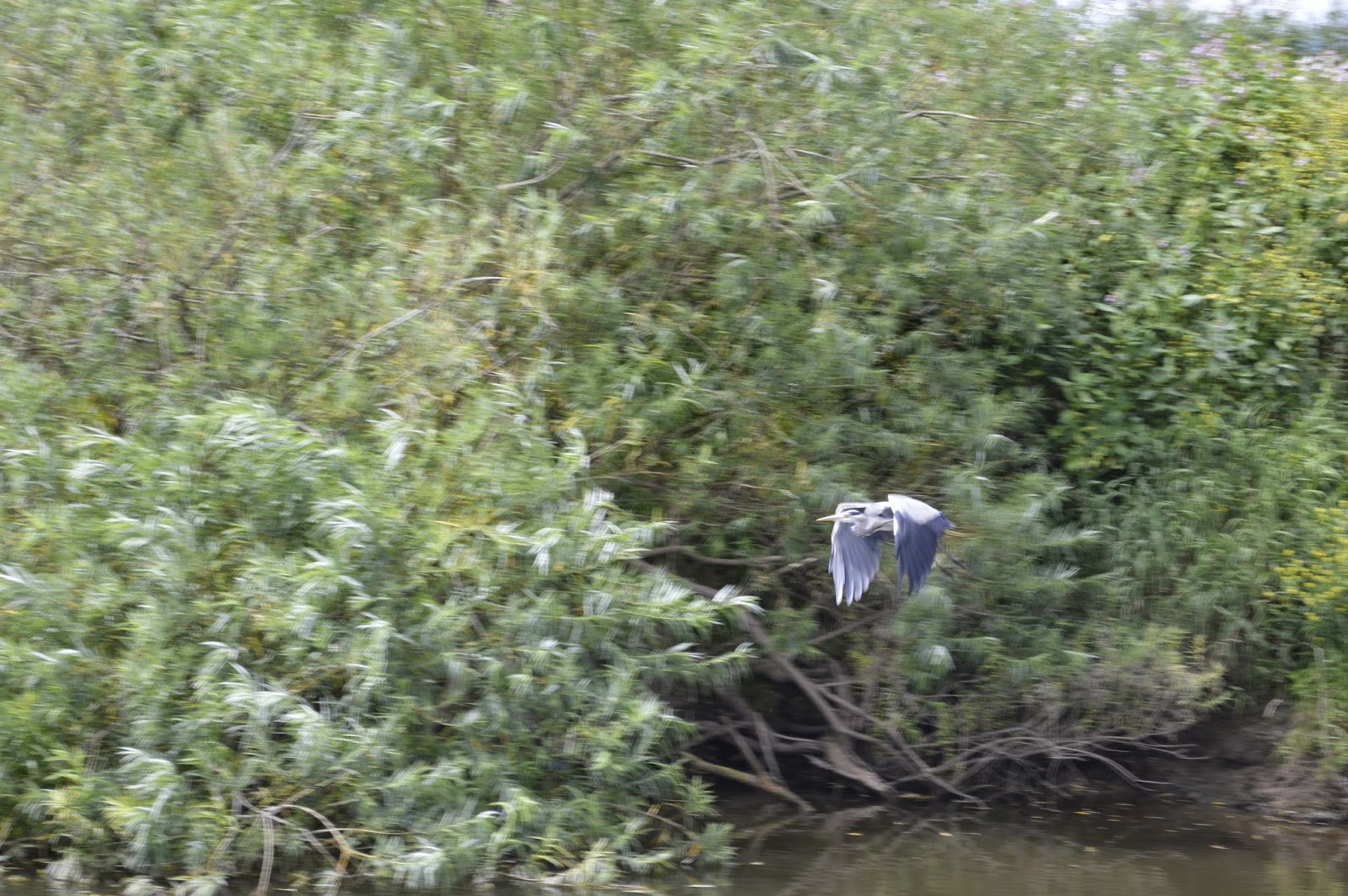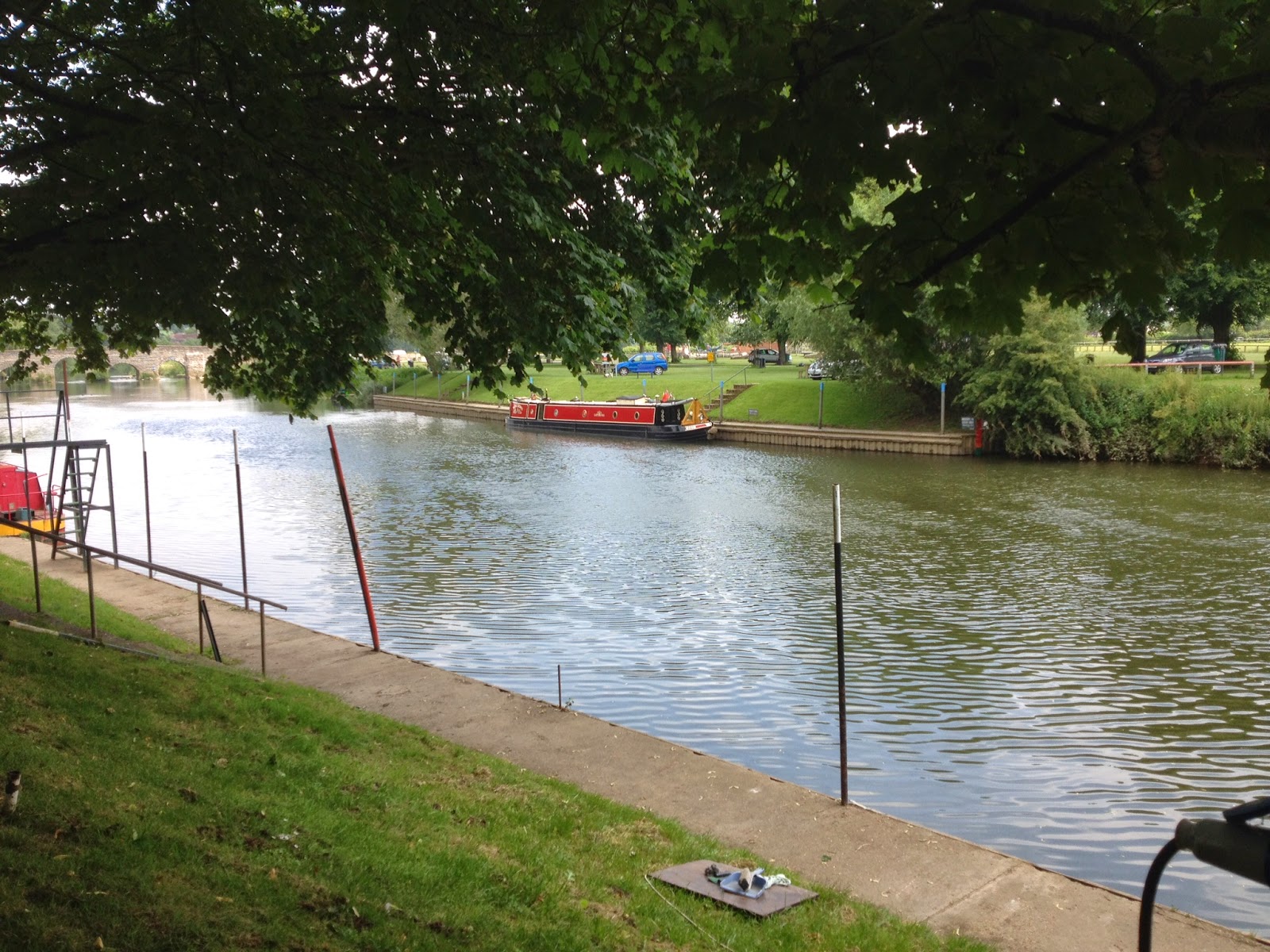Some repairs had to be done to the boat's cratch canopy and Ian had made arrangements to pop into Wilson's in Kinver to have it mended on Monday 21st July. We had 10 miles and seven locks to do in the day so it was a relatively easy day. The navigation moved steadily through the town of Stourport and before long it emerged into the country following the west side of a valley; however our progress was partially blocked by a fallen tree.Ian managed to break off some of the protruding branches to give us sufficient space to pass and then we were on our way again.
There was some smart new development as we entered Kidderminster and a little further on the canal crept under a town centre roundabout only to emerge at Kidderminster lock overlooked by a lovely church. What a contrast in a matter of a few yards!
The day that had been overcast, brightened, and all too soon the bright sun was beating down as we left Kidderminster and emerged once more into the countryside. The navigation then becomes more tortuous and narrow as it was forced into endless diversions by steep cliffs of red sandstone.
Beyond the Cookley tunnel the navigation emerged once again into countryside as it made its way to Kinver. The visitors mooring are on the south side of Kinver lock but we had to go through the lock in order to fill up with water. This was inconvenient as above the lock is only long term mooring. After taking on water we were faced with the prospect of reversing back down the canal and through the lock. A local man then told us that between the lock operation and the water point there is mooring reserved for a trip boat that was no longer around and that sometimes visitor boats moor there. That solved our problem; we cheekily used this trip boat mooring for the night. Wilsons, the canopy people were alongside the lock and we didn’t want to move off too far.
On Monday, after dropping off the canopy for repairs, we worked one more lock (Hyde lock) and moored at a lovely location known locally as ‘The Beeches’. No sooner had we tied the mooring ropes when Wilson's phoned to say that the canopy was ready for collection, so we walked the mile back down the canal to collect it.
Later that afternoon we met Gail and John on NB Far Call and enjoyed a rather boozy afternoon and evening with them.
Tuesday morning was a beautiful morning. The sun peeped over the hill and shone through the mist that was rising from the canal. We could hear sheep in the field calling to one another just to complete this idyllic picture. It was breath-taking and a small reminder of what we love so much about our nomadic lifestyle.
Later that day was not so glamorous. We entered a very crowded Ashwood Marina where we would leave the boat for 2 nights while we went to Reading for doctor appointments. We were surprised to find that even though we had phoned and book a slot well in advance, we were not even given a proper mooring but rather stuffed between other moored boats and that meant that not only did we have difficulty getting on and off the boat but we didn't even have the option of an electrical hook up. Oh well, it was only for 2 nights and we did have the 'feel safe' factor when we left the boat.
A few days later, after having done a little shopping and returning the hire car, it was mid-afternoon before we were ready to leave the marina. We were not happy to find that we had to return to Kinver as we had discovered another problem with the canopy. To make matters worse, it was only when we wanted to turn to re-trace our steps that we realised there was nowhere to turn the boat around. The marina was so overcrowded that the turning point had been stuffed with moored boats. We had to reverse out of the marina and then continue north for a little over a mile (and another lock) before we could turn and come back. Although it was only 5 locks and 4 miles back to Kinver, the day was hot and humid and we felt little inclined to go very far so we chose to stop at a lovely spot close to bridge 34, Prestwood bridge, and have a BBQ. We thought that we would easily complete those few miles and locks the following day.
Best laid plans… we set off for Kinver shortly after 8 o’clock and had only gone half a mile when we rounded a tight turn aptly called ‘Devil’s Den’. Coming in the opposite direction was a hire-boat that had passed us earlier. The lady waved frantically and called out to us as we came alongside. She told us that a tree had come down in the night and had completely blocked the canal less than a mile further on. Well, we were well and truly stuck. The point where they turned was not a winding hole and they were considerably shorter than we were so we couldn't follow suit. We had no choice but to moor up and wait. Canal & River Trust officials were already at the tree by the time we reached it but the huge oak needed specialist equipment to move it. The bad news was the tree couldn't be moved for another day or so. We just had to be patient. Undeterred, we folded the canopy into our shopping trolley and walked the two miles along the towpath to Kinver.
We had been told about the rock cottages on the outskirts of Kinver and since we now had time on our hands, we set off to find them. It was well worth the additional 3 miles that we had to go and we did have all day! However, the canopy had been finished while we had a cup of coffee so we folded it back into the trolley and dragged it up the steep hill to the rock cottages – not such a good idea as it was extremely hot and humid. Nevertheless, we were well rewarded for our efforts and spent a few hours steeped in the history of the cottages before trundling back down the hill and along the towpath to the boat.
It is thought that the rock cottages were the inspiration for Tolkien’s hobbit hole in ‘Lord of the Rings’. No-one is quite sure who first carved out the sandstone cliffs to create weatherproof homes and there is no evidence to suggest that they were prehistoric but there is an early iron-age hill fort situated only 150m further along the ridge that dates back to 200BC.
In 1777 a traveller by the name of Joseph Healey discovered the cottages after he had been caught in a thunderstorm while walking on the sandstone ridge. He was offered shelter which he accepted and later described the dwellings as "curious, warm and commodious and the garden extremely pretty."
There are many similarities between the Kinver Rock Cottages and Tolkien’s description of the Hobbit hole that it became an obvious assumption that he must have visited these remarkable dwellings that were still inhabited until the 1960s. Well whether he did or not, we thoroughly enjoyed our exploration.
Saturday proved to be another interesting day as we watched the fallen tree being cut up and dragged up the steep slope to clear the canal. The contractors brought in two 20 ton winches attached to ex-army vehicles that were once used to drag tanks out of quagmires.
Work began shortly after 8 o’clock and the poor workman had a captive (and critical) audience. By this time there were more than 30 boats that were held up by the blockage and this equated to quite a curious crowd. No pressure then!
To make their task more difficult a bee’s nest was discovered in the fallen tree. Geoff, one of the contractors was stung by an angry bee as he cut through the huge trunk of the oak tree.
The enormous root ball had to be supported to stop it sliding into the canal and then the tree was cut in half. It was a bit like watching someone cut off a branch of a tree while sitting on it. The contractor (Geoff) had to stand on the trunk while he cut through it with a chainsaw. We all held our breath as the trunk split in two and fortunately, Geoff retained his balance! Still supporting the root ball, the severed trunk was hauled around again (almost as if it was being re-planted) so that it could be dragged up the steep embankment. Next, the top of the tree was dragged back across the canal before it followed its bottom half up the slope. Neatly done!
By early afternoon, the canal was clear and boats had started to move again. Since we had arranged that we would meet up with Geoff, Lynn and James on the Sunday and the canopy had in the meantime been sorted out, we were in no particular hurry to go anywhere. We moved on through the now cleared canal and moored only a few hundred yards along at Stourton Junction. We were certainly glad that we hadn't got caught up in the 'Log jam' of boats all trying to get through the single locks!
Sunday, after meeting the Booth family, we worked our way up the beautiful Stourbridge canal and branched off at the Stourbridge town arm, turning at the end almost in Stourbridge town centre. After a short walk we found that the Talbot Hotel was doing a Sunday Carvery - perfect - and they had an available table! We had a lovely lunch before returned to the boat, giving the Booth family (and us)a really relaxing day.
Monday 28th we untied the mooring ropes and continued our northerly course along the canal. This time we got as far as the Bratches. We passed through some lovely countryside before the navigation was flanked by the neatly trimmed gardens of Swindon, (Staffordshire) then on into rural countryside again before passing through the modern outskirts of Wolmbourn.
 |
| Bratch locks |
We found lovely visitor mooring before the Bratch locks so we decided to end the day right there. Sometime later we were invited for an evening drink with Judy and Roger aboard NB Gabriel Oak, moored in front of us. This lovely couple (a little older than us) spend half of the year in Cape Town and the other half divided between their London home, their Guernsey home and their narrowboat. How the other half live!
The following morning, Judy and Roger set off fairly early, wanting to get through the set of three locks as soon as the lock keeper came on duty. We chose to explore the village and moved off in the early afternoon.
Once again, we didn't get very far. The countryside opened out above the set of locks giving lovely vistas all round. it was too good to pass up so we decided to say for a little longer and only move off the following day. It gave me time to write postcards and catch up on my blog while Ian planned our winter holiday in Spain.
What a tough life we lead!














































